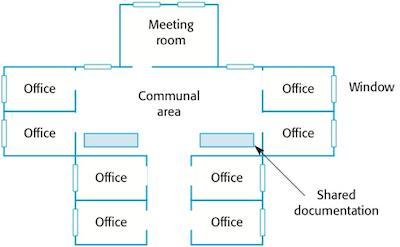
Providing individual offices for software engineering staff can make a significant difference to productivity. DeMarco and Lister (DeMarco and Lister, 1985) compared the productivity of programmers in different types of workplace. They found that factors such as a private workspace and the ability to cut off interruptions had a significant effect. Programmers who had good working conditions were more than twice as productive than equally skilled programmers who had to work in poorer conditions.
Development groups need areas where all members of the group can get together as a group and discuss their project, both formally and informally. Meeting rooms must be able to accommodate the whole group in privacy. Individual privacy requirements and group communication requirements seem to be exclusive objectives. McCue suggested grouping individual offices round larger group meeting rooms, as shown in Figure 1, was the best way to reconcile these conflicting requirements.

Figure 1 Office and meeting room grouping
A similar model is suggested by Beck in his description of an environment for ‘extreme programming’. However, he suggests retaining an open-plan area with all programming activities taking place in the communal area and individual cubicles for the group members when they wish to work alone. Clearly, the key requirement is to provide both individual and group space so that people can work alone or as a group when necessary.
This type of communication helps people solve their problems and exchange information in an informal but effective way. Weinberg (Weinberg, 1971) cites an anecdotal example of how an organisation wanted to stop programmers ‘wasting time’ talking to each other around a coffee machine. They removed the machine then immediately had a dramatic increase in requests for formal programming assistance. As well as gossiping around the machine, people were solving each other’s problems. This illustrates that companies need informal meeting places as well as formal conference rooms.